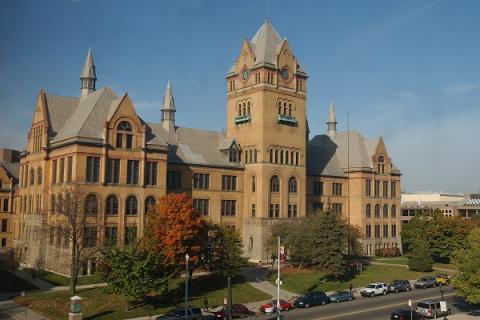Wayne State University
Institute

Wayne State University
Department of Physics and Astronomy
135 Physics Building
Detroit, Michigan 48201
USA
+1 (313) 577-2721

Wayne State University
Department of Physics and Astronomy
135 Physics Building
Detroit, Michigan 48201
USA
+1 (313) 577-2721
The particle physics group at Wayne State University investigates the constituents of matter at the smallest achievable scale with the goal of better understanding the particles and forces from which our universe is built. The research is carried out with the largest scientific instruments ever constructed, the Large Hadron Collider (LHC) at the European particle physics laboratory CERN, near Geneva, Switzerland, and the Tevatron collider at Fermi National Accelerator Laboratory in Batavia, Illinois. These instruments collide high energy beams of protons (and anti-protons at the Tevatron) and we observe the debris of the collisions with massive detectors surrounding the collision points. The group at WSU collaborates with researchers from around the globe on the Compact Muon Solenoid (CMS) and Collider Detector at Fermilab (CDF) experiments at the LHC and Tevatron , respectively.
The Wayne State group helps operate the endcap muon system and the hadron calorimeter of the CMS detector. The group is responsible for software and data quality monitoring for the endcap muon system. This system is vital in selecting events containing high energy muons, an important signature of some hypothesized new particles, as well as the known W and Z particles. The hadron calorimeter is used to measure jets of particles which carry critical information about existing or possibly new particles. A new type of light detector, the silicon photo-multiplier is being used to enhance the performance of the hadron calorimeter. The Wayne State group takes a leading role in the search for a possible underlying structure of quarks and leptons, based on the production of muon pairs.
The Wayne State group takes a leading role in the operation of the CDF detector. They are known for their measurements of "heavy flavor" particles containing the "charm" or "bottom" quark, and searches for a light Higgs boson.
The group consists of Profs. R. Harr, P. Karchin, M. Mattson and C. Milstene. This work is carried out with the assistance of postdoctoral researcher Dr. A. Sakharov, research engineer A. Gutierrez, and graduate students S. Gollapini, P. Lamichane, C. Kotachchi, and C. Clarke, and supported by the United States Department of Energy.

